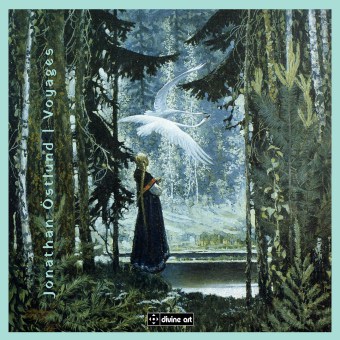His Voice
In one year, two new albums have been introduced with the music of the contemporary Swedish composer Jonathan Östlund: 2019’s double CD Voyages and 2020’s Mistral elevate him to the status of the 21st century’s Debussy.
I have already written about Östlund in connection with the first album for the British-American label Divine Art Records, which was released under the name Lunaris in 2016 (here). Both new titles contain vocal works, solo instruments (including organ), chamber and orchestral works.
The Voyages double album (Divine Art DDA 21232) features 23 small and larger compositions and four suites, all inspired by nature, folk music from various countries, the creator’s experiences, his passion for life, his defiance of inexorable time…, in the interpretation of an international range of excellent soloists and ensembles.
The first disc (78:44) opens with bird singing and playful clarinet by (Canadian-American) Christine Hoerning in L´al di la Theme. A dramatic piano full of urgent expressions and lyricism describes the Etesian (the northern wind in the Aegean region); Evgheny Brakhman (Russia) performs superbly. Ukrainian pianist Sasha Grynyuk and Polish violinist Alicja Śmietana produce joyful and glorious tones in Twilight-wind and Mandolin. In Visions On the Wind, storms and a dramatic and mysteriously compelling piano roll under Grynyuk’s fingers. Veils of Night (7:15) is the first appearance here of the Swedish Orchestra Of Norrlandsoperan; a parade of colors, in places a dance to a circus rhythm, dramatic winds and spirited strings, an entire rush of the orchestra, all in fine dynamics. This is followed by the three-movement suite Folklore Fantasia for piano (8:31), in which Grynyuk again excels; the melodic passages in two counterbalanced voices alternate with the exuberant ones that bring dancing at a fair, as well as Eastern European folklore themes and echoes of the baroque.
The Air On a Grieg Theme for Solo Violin varies, in a neoclassical way, the melody from ‘In the Hall of the Mountain King’ from Peer Gynt, whereas in the Autumnal Aire we hear a darkly melancholic violin (both with Śmietana). The lyrical song Moonlight Wave gives pianist Evgheny Brakhman further emotion valences, including that of love. Clarinetist Christine Hoerning explores different forms of song in Fantasia pour trompette petite; then Brakhman again with his thorough and emotional performance presents a wonderfully atmospheric fable (Favola). American-Canadian flutist Rachael Elizabeth Cohen and clarinetist Hoerning play the joyfully expressive Aprés l´hiver (After the Winter) and then we have Syrinx et Pan with a thrilling new fantasy, in duet with the famous theme by Debussy. There is a five-movement suite Jeux Pour Deux (14:05), which closes the first disc; the Spanish Duo Almira (flutist Isabel Gonzáles and bassoonist Paula Jimenéz) play with contagious exuberance: games full of joy, anticipation, excitement, passion, frivolity, tension, with strong alternating emotions and an almost baroque climax.
The second disc (74:44) begins with typically Bach cascades in the witty Fantasia on Bach’s Badinerie (Evgeny Brakhman). The first vocal piece, Berceuse Bergamasque, is set on the text of the poem Clair de Lune by Paul Verlaine; the submersive lyric is enhanced by Estonian pianist Harry Põlda and French soprano Manon Gleizes. The Orchestra Of Norrlandsoperan displays tense dramatic string playing in the second appearance, The Aura (6:23), while the percussion breaths with marching pressure on the soul. In Dacian Prayer (9:09), the Russian cellist Alexander Zagorinsky and the Norwegian pianist Einar-Steen Nøkleberg are in an emotional battle; inspired by the spiritual world of antiquity (the ancient empire of Dacia), this masterpiece is a precursor to the following two-movement composition Two Fantasias on Ancient Hymns (7:54) for the organ, performed by the great Italian master of the royal instrument Walter Gatti; in the first movement, Flowers of Joy, he interprets a powerful battle of joy and uncertainty, while in the second movement, The Shepherdess, the composer expresses the sadness of solitude, hence the desire or yearning for a woman (the shepherdess). The following Winter Cathedral represents an organ burst of light; the composer also used minimalist methods in this work. Debussy’s Impressionist and frenzied flute is re-created in Air dans l´air (6:18) by the Swiss flute player Myriam Hidber-Dickinson. Spiritual power, and a minimalist anthem in Gate of Northern Lights (4:02) are communicated with admirable persuasiveness by organist Gatti and violinist Elena Saccomandi. This is followed by the three-movement Sonatine Lyrique (13:42), in which the Trio Tempora (Romanian clarinetist Marius Birtea, French cellist Madeleine Douçot and Hungarian pianist Emese Badi). The lyric of soft colors alternates with dramatically alluring melodies of considerable emotional power, smoothness contrasting with sharpness, and question marks with reconciliation.
Tense emotions, drama, and lightning are presented by the Oblivion piano quartet (6:40), in which Russian violinist Vladimir Spektor, Russian violist Ksenia Zhuleva, cellist Zagorinsky and pianist Nøkleberg play as if their lives depended on it. Following this is the narrative song Erlkönig, the musical ballad about the King of Ghosts, written by J. W. Goethe; we experience storms and fear from the heroic tenor Artjom Safronov, accompanied by pianist Brakhman. The disc ends with a return to the organ (Gatti) in The Stair, which in a burst of joy, and erupts into a brief outpouring of festive music from the Baroque to the present…
@divineartrecordingsgroup
A First Inversion Company
Registered Office:
176-178 Pontefract Road, Cudworth, Barnsley S72 8BE
+44 1226 596703
Fort Worth, TX 76110
+1.682.233.4978












